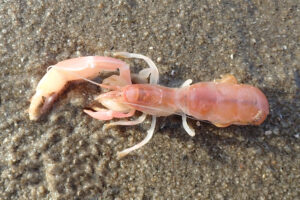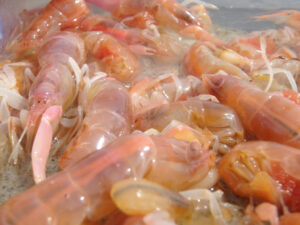Bay Ghost Shrimp, Neotrypaea californiensis
 Bay Ghost Shrimp, Neotrypaea californiensis. Shrimp collected via plunger in Mission Bay, San Diego, California, March 2018. Length: ca. 10 cm (4.0 inches). Catch, photograph and identification courtesy of Ben Cantrell, San Diego, California.[
Bay Ghost Shrimp, Neotrypaea californiensis. Shrimp collected via plunger in Mission Bay, San Diego, California, March 2018. Length: ca. 10 cm (4.0 inches). Catch, photograph and identification courtesy of Ben Cantrell, San Diego, California.[
 Bay Ghost Shrimp, Neotrypaea californiensis. Shrimp collected via plunger in Mission Bay, San Diego, California, March 2018. Length: ca. 10 cm (4.0 inches). Catch, photograph and identification courtesy of Josh Leisen (joshadventures.com), Gaylord, Michigan.
Bay Ghost Shrimp, Neotrypaea californiensis. Shrimp collected via plunger in Mission Bay, San Diego, California, March 2018. Length: ca. 10 cm (4.0 inches). Catch, photograph and identification courtesy of Josh Leisen (joshadventures.com), Gaylord, Michigan.
Phylogeny: The Bay Ghost Shrimp, Neotrypaea californiensis (Dana, 1854), is a member of the Callianassidae Family of Ghost Shrimps. The Callianassidae Family has one hundred seventy individual species that have been placed into twenty-six genera. The Neotrypaea Genus of ghost shrimps has five global members. They are also known as the Bay Mud Shrimp and the Pink Ghost Shrimp. The Bay Ghost Shrimp is known in Mexico as Camarón Fantasma.
Morphology: The Bay Ghost Shrimp are translucent with patches of white, pink, yellow, and orange on the appendages and pink abdomens. Their exoskeleton has very little calcification, which causes it to be translucent. The legs and claws contain more calcium to be rigid and strong, so they have a white color. They have elongated bodies with one master claw that is significantly larger than the other, especially in males, and has an equal chance of being on the right or left side of the body. In males, this master claw can be up to 25% of the total body mass and up to 10% in a female shrimp. The smaller claw is approximately one-eighth the size of the master claw. The Bay Ghost Shrimp lack a rostrum, the beak protruding from the front of the head, and the acute diverging tip of the eyestalks found in other species in the Neotrypaea Genus. They reach a maximum of 11.5 cm (4.5 inches) in length.
Habitat: The Bay Ghost Shrimps reside in mudflats and sandy substrate in the intertidal zone of estuaries. They live in extensive burrow systems that can be 76 cm (2 feet 6 inches) long that have many branches that are shared with other small animals including copepods, crabs, shrimp, and worms that find food, shelter and protection within from predation. The Bay Ghost Crabs provide high levels of bioturbation to the local environment.
Symbiosis: Inside their burrow systems, commensalism may occur between a variety of species including the snapping shrimp, the pea crab, and the goby shrimp. These species use the Bay Ghost Shrimp’s burrow as their own habitat too.
Reproduction: Females lay an egg that is attached to the females body. The eggs then hatch into planktonic larvae. They are very hardy, having the ability to survive without oxygen for as long as 6 days.
Distribution: The Bay Ghost Shrimp is found along the Pacific Coast of Canada, the United States and Mexico ranging from as far north as Mutiny Bay, Alaska to Punta Abreojos, Baja California Sur.
Diet: The Bay Ghost Shirmp are deposit feeders consuming bacteria, detritus and plankton. In turn they are preyed upon by bottom dwelling fish.
Human Impact: The Bay Ghost Shrimp are utilized primarily by surf fishermen as a bait. They are collected by utilizing a plunger that sucks the shrimp out of their burrows at levels that are approximately 5,000 kg (11,000 lbs) annually. In some areas they have a major negative impact on oysters raised by aquaculture and are considered to be pests and are the target of eradication programs that utilize pesticides. They play an important role in the ecosystems of the estuaries.
Synonyms: Callianassa californiensis, Callianassa occidentalis, Trypaea californiensis